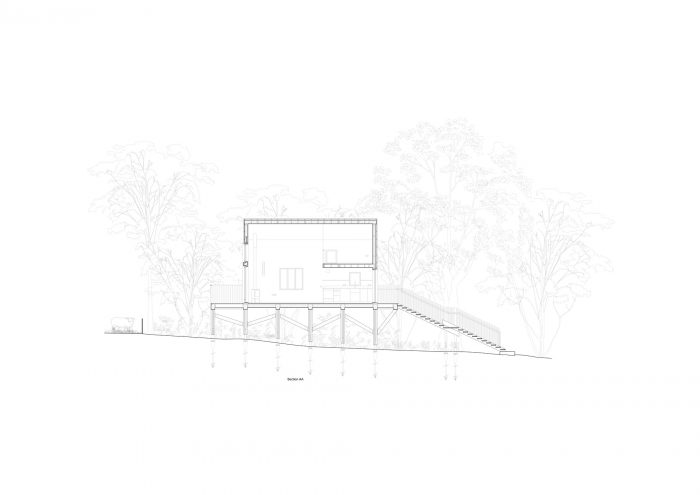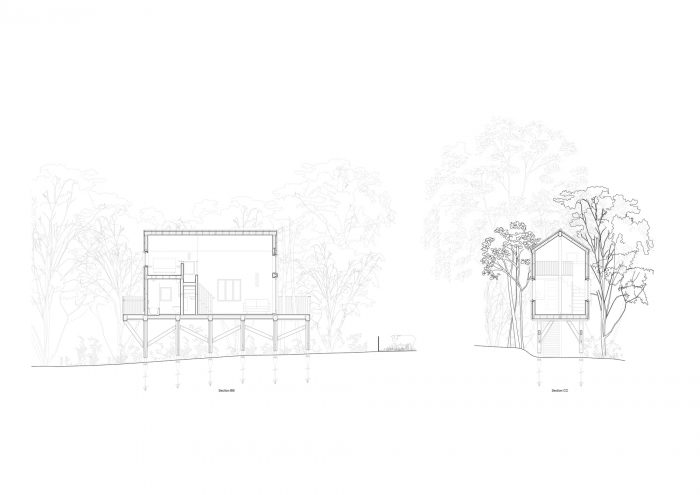这个自建项目位于赫里福德郡西南部的一个27英亩的农场,位于一条古老的赶车人小道上,周围是杂草丛生的灌木丛和树木。它最初被委托作为一个低影响的树屋,但在勘察现场后,认为从任何树木上支撑一个结构是不合适的。
The self-build project is on a 27-acre farm in South-West Herefordshire, located up an old drovers’ track and surrounded by overgrown hedgerows and trees. It was initially commissioned as a low-impact treehouse, but after surveying the site it was deemed inappropriate to support a structure from any trees.
相反,这个房子通过尽可能靠近树冠的建筑,重新诠释了生活在树冠下的体验,而没有砍伐或破坏它们的根部。这种雄心壮志与牧羊人的轨道的功能相结合,导致房子被抬起来,让羊群在下面放牧,大自然在结构周围茁壮成长;同时也使黑山的远景成为可能。比例和体量是由轨道的宽度以及树木的高度和间距决定的。树冠在隐藏建筑方面也发挥了关键作用,这是获得规划的前提条件。
Instead, the house reinterprets the experience of living within the tree canopies by building as close as possible to them, without felling or damaging their roots. This ambition combined with the functional aspect of the drovers’ track, led to the house being lifted up on legs, allowing sheep to be herded underneath and nature to thrive and grow around the structure; as well as enabling distant views of the Black Mountains. The proportion and massing were dictated by the width of the track, and the height and spacing of trees. The tree canopies also play a critical role in concealing the building which was a prerequisite for obtaining planning.
我们采用了预制的木板结构,并在橡木腿上加高,使下面有至少2米的净空。它挤在树木之间,树枝接触到建筑墙面,使人感觉它与周围环境同步生长。钢脚将橡树腿连接到地面以下的螺丝桩基础上,使建筑能够迷人地靠近树木,而不需要挖掘或混凝土。
A prefabricated timber panel construction was used and raised on oak legs to have a minimum 2m headroom below. It squeezes between the trees with branches touching the building walls, making it feel like it has grown in tandem with its surroundings. Steel feet connect the oak legs below ground to screw pile foundations, allowing the building to sit enchantingly close to the trees without the need for excavation or concrete.
狭窄的建筑通过一个长长的楼梯进入,促使人们不慌不忙地接近。辅助空间被有效地安排在不到一半的平面上,上面有一个厨房、浴室和夹层睡眠区。这让位于一个双层高的生活区,在小建筑内提供了空间上的宽松,一个大的开口向南望去,可以看到羊群的风景。
The narrow building is accessed via an elongated staircase prompting an unhurried approach. Ancillary spaces are efficiently arranged into less than half the plan with a galley kitchen, bathroom, and mezzanine sleeping area above. This gives way to a double-height living area, offering spatial generosity within the small building, with a large opening looking south over sheep fields to the landscape beyond.
两个面向东方和西方的折叠式窗户创造了有框架的绘画般的景色,使居民能够与树木亲密接触。较小比例的窗户被放置在烹饪、洗涤和睡眠区,以提供亲密的框架式视野和通风。当地采购的绿色橡木柱、粗锯的落叶松包层、橡木窗、回收的地板和回收的绝缘材料构成了主要建筑。通过用剩余的橡木下脚料和落叶松包层制作门和露台,将浪费降到最低。
Two folding windows facing East and West create framed painting-like views, allowing inhabitants to come in close contact with the trees. Smaller proportioned windows are placed within the cooking, washing, and sleeping areas to provide intimate framed views and ventilation. Locally sourced green oak columns, rough sawn larch cladding, oak windows, reclaimed floorboards, and reclaimed insulation form the main build. Waste was minimized throughout by creating doors and terrace decking from surplus oak offcuts and larch cladding.
橡木高架用螺栓固定在一起,以保证结构的完整性,免受强风的影响,同时也便于拆卸。我们的目的是使橡木结构和螺旋桩基础容易拆卸,并在使用后留下最小的痕迹。在服务方面,房子与农场的20个太阳能电池板相连,提供电力,并由天然泉水提供水源。
The oak stilts are bolted together with bespoke flitch plates for structural integrity from the strong winds, but also for ease of disassembly. It was intended that the oak structure, along with the screw pile foundations, be easily removable and leave a minimal trace after their lifetime. With regards to services, the house is connected to the farm’s 20 solar panels, providing electricity, with a natural spring providing the water supply.
Architects: Akin Studio
Area : 32 m²
Year : 2021
Photographs :David Grandorge
Manufacturers : Tadelakt, Louis Jobst Studio
Lead Architects : Louis Jobst, Ross Keenan
Structural Engineer : DAT Design
Build, Joinery And Furniture : Mark Hamilton Furniture
Bespoke Internal Lighting : Louis Jobst Studio
City : Newton Saint Margarets
Country : United Kingdom






















